What I Didn't See at Lake Shetek or know about—Until Years Later
What the words zhede, shetek and pelican have in common
Lake Shetek is a lake named after the Ojibwe word for Pelican. The lake is located near Avoca and Slayton. It was a place the Mineharts would picnic. Back when I visited my grandparents in the 1960s and '70s, I don’t recall seeing any pelicans at Lake Shetek. And, at that time, I had no idea what Shetek meant. I knew that Valhalla Drive was the main entrance to Lake Shetek State Park, and I knew Valhalla was from the Scandinavian immigrant influence. (Named after the Norse mythological heaven for warriors.)
Pelicans (Photo by Diane Hilden)
Much of southwest Minnesota is located in the prairie pothole region. (Image is Public Domain, https://commons.wikimedia.org/w/index.php?curid=3835897 )
Lake Shetek, the largest lake in southwestern Minnesota, is a rare gem in the prairie pothole region that stretches into Iowa and South Dakota. Because large lakes are scarce in that part of the state, Shetek has always been a popular spot for fishing, swimming and boating. Lake Shetek State Park lies on its eastern shore, drawing visitors throughout the summer.
While writing my creative nonfiction manuscript about Janette’s childhood and youth, I learned that there is a town in Wisconsin named Chetek, which is a different spelling of the Ojibwe word. The Ojibwe word is spelled azhede, but I think the zh sound is very similar to the Sh or Ch in English.
If you want to hear the Ojibwe pronunciation of the word, follow this link for sound of azhede.
It wasn’t until I attended my Uncle Ernie’s funeral in June 2011 and stayed at a fisherman's lodge on Lake Shetek that I truly noticed the pelicans. (Ernie is my father’s brother and is not a character in the manuscript, but he certainly is a character in my life. 😉 )
I wondered why there were so many pelicans and why they suddenly appeared. I visited Ernie on his lake cabin in 1987 and don’t recall seeing pelicans at the time. But while there for his funeral, the pelicans seemed to be plopped all over Valhalla Drive. They are large, peculiar-looking birds. Then, I learned about DDT, a type of insecticide. It was used during World War II to limit the spread of insect-borne diseases, such as malaria and typhus, among civilians and troops. After the war, it was promoted as an agricultural and household insecticide. Agricultural fields surround Lake Shetek. By 1972, a ban was placed on DDT. Only after the ban did bird populations begin to recover.
Some 14 years after Ernie’s funeral, my daughter and I joined Café Scientifique Twin Ports, a monthly gathering where scientists present talks in an informal setting. On Thursday evening, guest speakers discussed birds and the lingering impacts of DDT. (The room was packed.) The DDT causes the shells of eggs to be too thin, therefore reducing the number of chicks hatched. I thought back to Lake Shetek and the pelicans I finally noticed decades after my first visits.
I’ve looked online for specific information about the pelicans and the use of DDT near Lake Shetek, but I couldn’t find any relevant information.
I’m not sure if the pelicans stay at Lake Shetek all year round or if the reason I saw them in June 2011 is because they were migrating. According to the Minnesota DNR website, pelicans visit Lake Shetek in the spring and in the fall.
A pelican at on Lake Shetek on Saturday, April 26. (Photo by Victoria Bayer)
I've just learned about eBird, a tool for birdwatchers. A visit to that website shows that Daryl Hrdlicka spotted 70 individual pelicans on Sunday, April 13, 2025.
I contacted him, and he visited the lake again on Saturday, April 26, with Victoria Bayer, who took this photo of a pelican. “I just stopped at the ranger office at the state park,” Daryl Hrdlicka” said. “She says some stay here the entire summer. But they're more common in spring and fall when they migrate.”
If you would like to hear what sound a pelican makes, click on this link—a pelican call. In my opinion, it’s not a pleasant sound; it kind of sounds like a growl or a grunt.
Pelicans in Duluth
Currently, Pelicans are stopping on the St. Louis River in Duluth on their way north. On Friday afternoon, my husband and I visited Chambers Gove, which is on the east end of Duluth along the St. Louis River and near Jay Cooke State Park, as well as a stone’s throw from Wisconsin.
Now, every time I see pelicans soaring over Lake Shetek—or even along the St. Louis River—I feel like I'm seeing something both ancient and new, a creature we almost lost.
And ever since I was a child, I can’t think of a pelican without reciting to myself this poem by Dixon Lanier Merritt:
A Wonderful Bird Is The Pelican
A funny old bird is a pelican.
His beak can hold more than his belican.
Food for a week
He can hold in his beak,
But I don't know how the helican.
This is a photo I took of the Pelicans at Chambers Grove on Friday, April 25. Sorry, it’s a little fuzzy.
While we were pelican-watching, they were resting on the rocks of the St. Louis River near the south tip of Jay Cooke State Park. But I managed to catch these two in flight. The American White Pelican has a wingspan of 8 to 10 feet. (Photo by Naomi Yaeger)

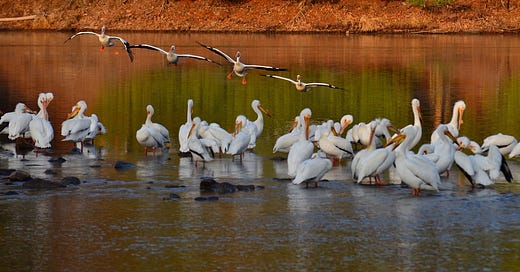




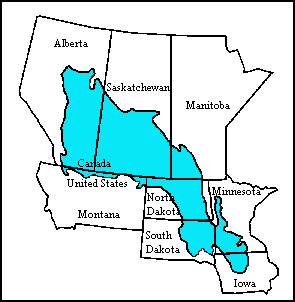
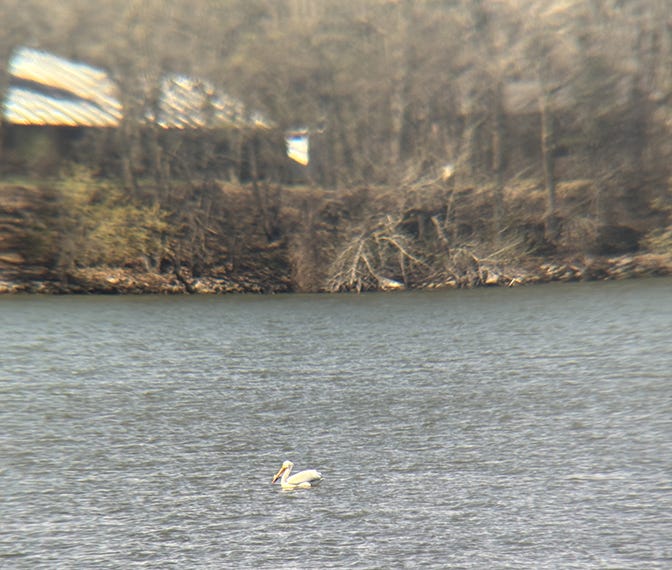
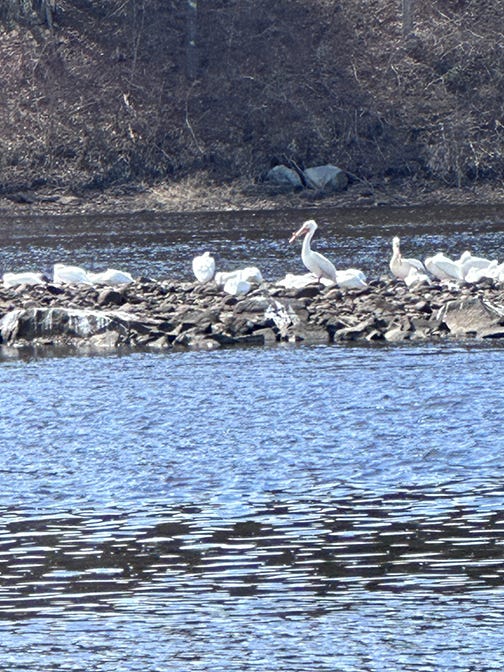
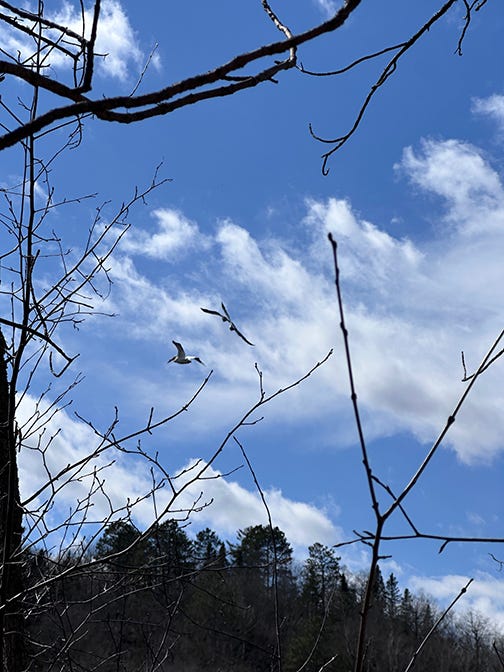
Interesting!
Naomi-Another indepth spin-off with photo support about you growing up. Good job. We went to see the pelicans at Chamber's Grove, too.